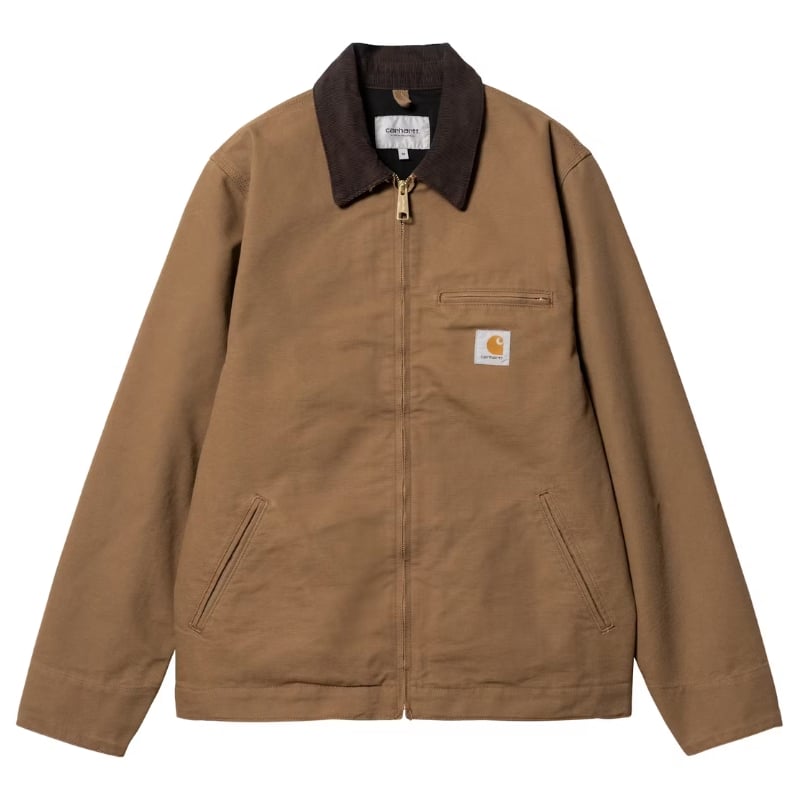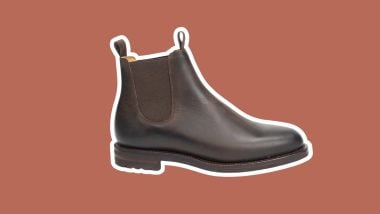The Carhartt WIP Detroit Jacket: How it Compares to the Original
I’m taking a close look at the Carhartt WIP Detroit jacket, a streetwear take on one of the most recognizable pieces of workwear on the market.
Workwear jackets modeled on the classic chore coat have been a cornerstone of durable outerwear for generations. One of the earliest American icons is Carhartt’s Detroit Jacket — originally introduced as the “Zipper Jacket” in the 1950s. Its rugged canvas construction, practical hardware, and no-nonsense design quickly won over laborers, and nearly 75 years later, it still exemplifies functional workwear.
WIP, the fashion-focused sub brand of Carhartt, deviates from the traditional Detroit jacket with a more expensive and style focused piece. I’m going to break down what makes WIP special, pros and cons, sizing, and if the WIP version holds up to the classic.
Disclaimer: Huckberry sent me this jacket as a sample for review. However, all opinions expressed in this post are entirely my own. Huckberry did not review this content before publication and will be seeing it for the first time along with you.
Pros and Cons: the Carhartt WIP Detroit Jacket
Before we get into the details, here’s a quick summary of everything I liked and disliked about this piece.
What I liked:
- Iconic style: It successfully adopts the classic Detroit jacket silhouette to streetwear style
- Comfortable right away: The rinsed canvas has a soft, post-broken-in feel
- Thick, 100% cotton canvas: While WIP is style centered, the 12oz canvas is still heavier than most casual canvas jackets
- Great for layering: Being unlined, it’s a versatile piece that works great for layering in transitional weather
- Made with organic cotton: This does make a difference to the environmental impact, if that matters to you
- Flattering fit: It drapes well, whether you’re wearing it over a single shirt or multiple layers, without looking bulky or too loose
A style-focused version of the original Carhartt Detroit jacket with a more modern design and softer canvas shell — which is still thicker than most workwear on the market.
Downsides not deal breakers:
- Steep price: At $248-$268, it’s over double the price of the standard Detroit jacket
- Not warm: Unlike the original, WIP’s is unlined — a great shell for layering, but you can’t deny it’s both less warm and more expensive than the original
- Less mobility than the original Detroit jacket, as it’s designed for a cleaner look
- Lack of transparency: No information about where the jacket is made, even on its own label
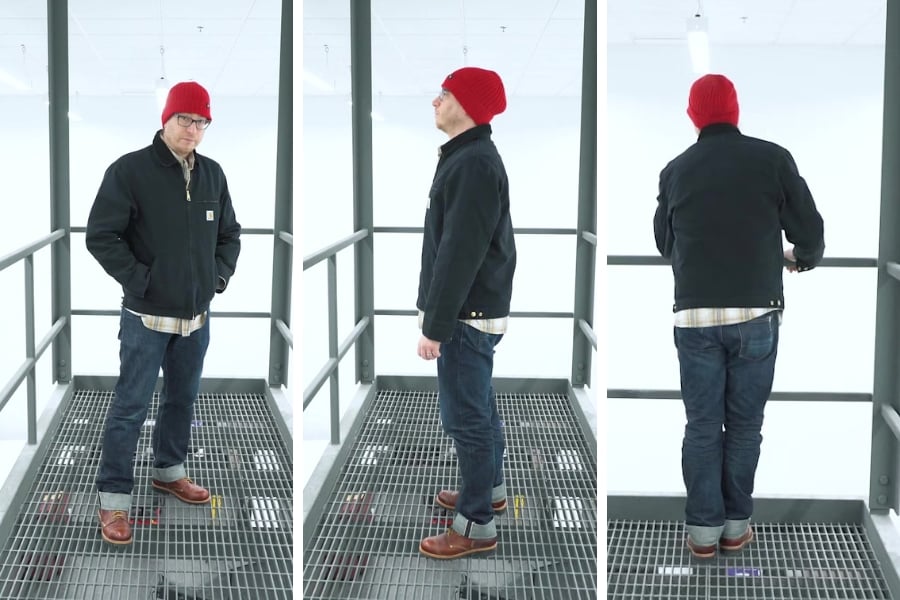
How I Tested It
I’ve spent about 15 years of my life selling Carhartt, and the original Detroit jacket has one of my all-time favorite silhouettes. I absolutely love its look. I used to have an old blanket-lined one that I adored, and I eventually gave it to my brother, who is a truck driver. He wore it until it practically disintegrated.
The J97, or the Detroit jacket as it’s more commonly known, is iconic. When I think of Carhartt, this jacket is often what comes to mind.
I’ve been wearing the Carhartt WIP for a couple of weeks now. This particular J97 styled model is unlined, made from a 12-ounce canvas. Since it’s currently mid-April, this jacket is suited for the current temperatures.
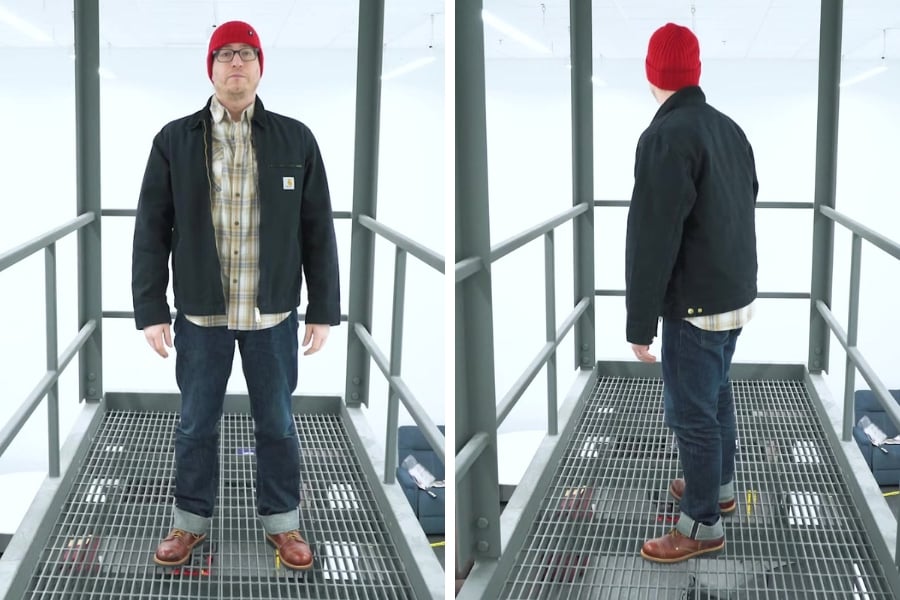
Carhartt WIP Detroit Jacket: Key Features & Specs
Let’s break down some specifics:
- Price: $268 for my black version, $248 for the more popular “Hamilton Brown”
- Pockets: Two hand warmer pockets and one zipper-closure chest pocket on the left side
- Material: Made from a 12-ounce, 100% organic cotton canvas.
- Lining: Unlined
- Origin: The tag says “imported”; evidence suggests it’s made in Tunisia
For comparison: The standard Carhartt J97 Detroit jacket usually costs around $110 for regular sizes and about $120 for tall or larger sizes.
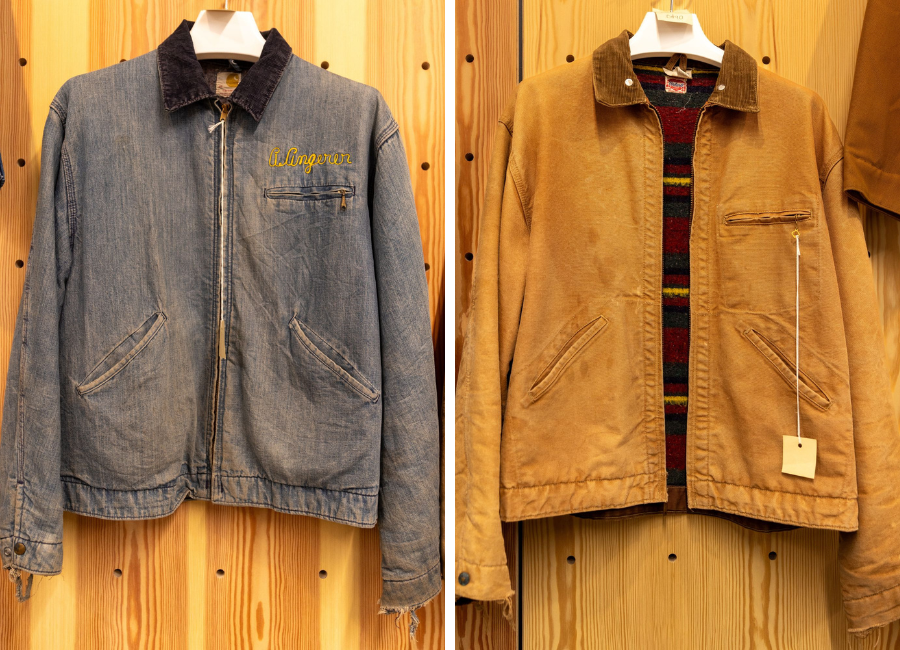
Carhartt WIP vs Carhartt
Carhartt began in Detroit in 1889 when Hamilton Carhartt founded Hamilton Carhartt & Co. with the motto “Honest Value for Honest Dollars.”
It supplied uniforms for both World Wars, by which point it had expanded into multiple U.S. states as well as Canada, the U.K., and France.
After Hamilton died in 1937, the family retained ownership. In 1989, Swiss designer Edwin Faith brought Carhartt into the fashion world, securing European distribution in 1994 and launching Carhartt WIP in 1996 — splitting the brand into its original workwear line and a stylish “work in progress” fashion imprint.
The two Detroit jackets are nearly identical; the big differences are that the WIP doesn’t have the full swing designs on the elbows and the shoulders, so it doesn’t allow for the same range of motion that makes the original Detroit jacket suitable for work.

Sizing and Layering
- More form-fitting than other J97, which has a looser, functional fit that’s common with workwear
- Still able to wear layers undearneath
I’m 5’9”, weigh around 175 to 180 pounds, and I’m wearing a size Large in the WIP Detroit jacket. The size Large fits me really well: when learning that WIP is “fashion focused” you might have worried this jacket would be slim, but it’s got a streetwearish relaxed fit: the Detroit jacket layers nicely, even over two layers. That’s a big plus.
On milder days, I’ve enjoyed wearing it over a denim Western shirt; since that’s a thicker kind of shirt, it’s been a comfortable combination on 40-degree days. On colder mornings I’d add an undershirt, and even then I had plenty of room to move around in this roomy jacket.

The unlined nature of this WIP version makes it more versatile than the traditional Detroit jacket, which has a blanket liner. I can use a patterned shirt as a mid-layer for warmth and style. Then, at the end of the day, when it’s a bit warmer, I can shed one of the inner layers and keep the Detroit jacket as a windbreaker.

The Zipper: A Minor Quibble
- Zipper is positioned on the left, unlike most of my jackets
One thing I don’t particularly like is that Carhartt WIP has the zipper on the left, the inverse of the standard for men’s jackets in the US. The zipper itself works perfectly fine, but the change in orientation makes zipping and unzipping a little awkward.
It’s similar to how most guys probably won’t have noticed that all their shirts have their buttons on the same side until they try one that doesn’t. When taking the jacket off, I get to the bottom, and my muscle memory tries to pull the zipper apart in the usual way.
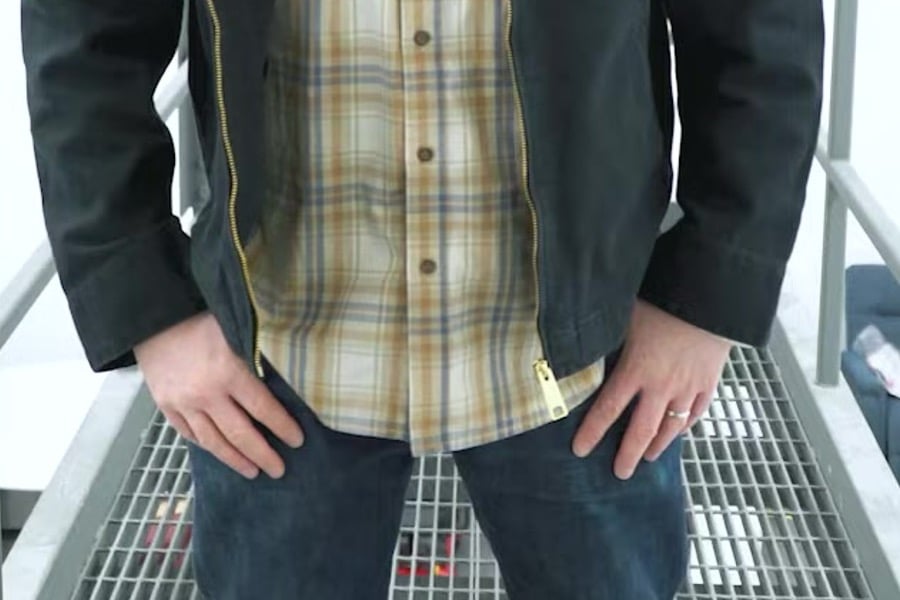
How to Wear It
- Great spring jacket
- Easy to layer with a t-shirt, button-down shirt, or hoodie
This WIP version has been a great jacket for spring. The sizing feels right, and it drapes well over the body thanks to it being 100 percent cotton and thanks to the fact that it’s been rinsed to give it a soft, broken in feel.
I can wear it over a simple button-up shirt, layer it with a heavier shirt, or even toss it over a hoodie, and still have plenty of room. Importantly, it doesn’t look bulky when layered, nor does it look overly big or sloppy when worn with just a single shirt underneath.
WIP Detroit vs Original Detroit Jacket
- $100 more than the standard Detroit Jacket
- WIP’s canvas is much softer and the cotton is organic
- OG jacket is warmer because it’s lined
- OG jacket is built for more mobility, WIP is built for a cleaner look
Having worn and sold a lot of Carhartt, I know that duck canvas is very stiff and not always the most comfortable. This might be the biggest advantage of the WIP version: it’s been stonewashed to soften it so that you don’t need to break in the canvas.
It’s much more pleasant right out of the box. The original Detroit jacket feels very rigid for a very long time. You have to earn a soft Detroit jacket, but the WIP gets you there immediately.
The biggest advantage of the original Detroit jacket is that it’s cheaper and it’s lined, so it’s both more warm and less expensive. Neither jacket, however, is made in the USA, so there’s no “home field” advantage to be found.

Is WIP’s Detroit Jacket Worth the Price?
Do I think it’s worth $268? Not really, especially since they won’t even tell you where it’s made.
The original Detroit jacket isn’t made in the USA anymore. If the WIP was made in the USA, I might be persuaded to see the price difference as justifiable. But as it is, you’re getting less jacket (WIP is unlined) and less mobility for twice the price.
I know that it’s not very expensive to stonewash a jacket, so the main justification for its cost would be that it’s made of organic cotton.
That’s pretty cool if that matters to you — a lot of the world’s pesticides are used on conventional cotton production. This might be your pet cause and you might be stoked to have an organic version of America’s most iconic workwear jacket.
If that doesn’t matter to you, the main benefit of this jacket is that it’s softer and you can wear it in a wider range of temperatures. If it was the same price as the original, or if it were made in the USA, I’d have no problem pointing you toward the WIP jacket.
Still, it is a great jacket. If you see one on sale — and Huckberry does run sales fairly often — I’d recommend snagging one. If you can get it closer to the $200 mark, I think that’s a fair price for what you’re getting. It’s comfortable, fits well, wears well, and will last a really long time.
A style-focused version of the original Carhartt Detroit jacket with a more modern design and softer canvas shell — which is still thicker than most workwear on the market.

Wrapping Up
That’s my breakdown of the Carhartt WIP Detroit Jacket. If you don’t like the stiff feeling of new canvas, if you prefer organic cotton, or if you want a Detroit jacket you can wear for more seasons than the blanket-lined original, it’s probably worth the extra cost.

